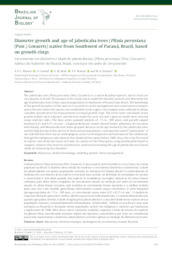Diameter growth and age of jaboticaba trees (Plinia peruviana (Poir.) Govaerts) native from Southwest of Paraná, Brazil, based on growth-rings.
Diameter growth and age of jaboticaba trees (Plinia peruviana (Poir.) Govaerts) native from Southwest of Paraná, Brazil, based on growth-rings.
Autoria: MOURA, A. P. C.; CANETTI, A.; BRAZ, E. M.; MATTOS, P. P. de; DANNER, M. A.
Resumo: The jaboticaba tree (Plinia peruviana (Poir.) Govaerts) is a native Brazilian species, and its fruits are very popular in Brazil. The purpose of this study was to model the diameter growth, and determine the age of jaboticaba trees in four natural populations in Southwest of Paraná State, Brazil. The knowledge of the growth dynamics of this species is essential to assist management and conservation strategies and to discover when this species was established in the region. Core samples were collected to obtain complete growth series by measurement of annual growth rings. The series were crossdated, seven growth models were adjusted, and the best model for each site and a general model were selected using statistics rules. The time series spanned periods of ~75 to ~100 years, and growth ranged between 0.27 and 0.37 cm year-1. Chapman-Richards’ model showed better adherence for locations individually, and Monomolecular when grouped. Because to the age reached by the jaboticaba trees and the high density of this species in these natural populations, consequently named “jaboticabais”, it was inferred that there was an anthropogenic action in the dispersion and formation of the settlements through the indigenous and caboclos that inhabited the region before 1940. Also, this is the first work to register and verify the fusion of trunks for species of the Plinia genus using double piths found in samples, a feature that must be considered to avoid overestimating the age of jaboticaba trees based solely on measuring tree diameter.
Ano de publicação: 2024
Tipo de publicação: Artigo de periódico
Unidade: Embrapa Florestas
Palavras-chave: Crescimento, Dendrochronology, Dendrologia, Floresta, Forest management, Growth models, Manejo, Myrtaceae
Observações
1 - Por padrão são exibidas publicações dos últimos 20 anos. Para encontrar publicações mais antigas, configure o filtro ano de publicação, colocando o ano a partir do qual você deseja encontrar publicações. O filtro está na coluna da esquerda na busca acima.
2 - Para ler algumas publicações da Embrapa (apenas as que estão em formato ePub), é necessário ter, no celular ou computador, um desses softwares gratuitos. Sistemas Android: Google Play Livros; IOS: iBooks; Windows e Linux: software Calibre.
Acesse outras publicações
Acesse a Base de Dados da Pesquisa Agropecuária (BDPA) para consultar o acervo completo das bibliotecas da Embrapa.

